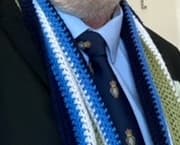The Covid pandemic had an undeniable impact beyond people’s immediate physical health as millions suddenly found themselves with a lot of free time on their hands thanks to lockdown.
Some simply spent more time watching TV, bingeing on their favourite shows, while others decided to learn new skills, such as playing a musical instrument.
In Alan Quester’s case, the result of lockdown was rather more intriguing and arguably deserving of greater praise.
The 76-year-old retiree spent almost two years cutting, shaping and assembling pieces of timber and other materials he found in his garage to build a 5ft long by 5ft tall replica of a famous 17th century Royal Navy warship, the HMS Ramillies.
The feat is all the more remarkable as Mr Quester had never undertaken such a project before - the closest he ever got was building Airfix kits as a child.
“I just wanted something to do during lockdown. All the timber I used were the bits I had around the house,” said Mr Quester, who believes the model is a faithful replica of the warship.
Mr Quester did not obtain copies of the original design plan to base his replica on but used his intuition to calculate the dimensions and look of the vessel.
He said: “I think that several ships were built to the same plan. I may be wrong, but that’s the way I understood it. When I made it I was considering having a pull-out section so that you could see below decks, but that was a bit too much for me!”
The ship holds special significance for Mr Quester as he dived the wreck of the real HMS Ramillies 50 years ago, in 1973.
Launched as the Royal Katherine in 1664 during the reign of Charles II, the ship was later renamed HMS Ramillies and served for a staggering 96 years as an 84-ship of the line.
During that time she took part in the Anglo-Dutch wars, the War of the Spanish Succession and The Seven Years’ War before sinking off the coast of Devon, at Bolt Tail near Salcombe, during a storm on February 15, 1760.
More than 820 men drowned in the tragedy and the shipwreck now lies in about 30ft of water.
Mr Quester, who lives in Shropshire some 225 miles away, said he hoped to exhibit the replica at a local museum in Devon but admitted he was also considering selling it.




